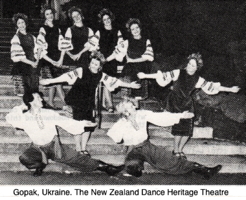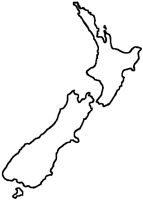
|
The Society of Folk Dance Historians (SFDH)
Folk Dance in New Zealand
[
Home |
About |
Encyclopedia | CLICK AN IMAGE TO ENLARGE |

|
 Folk dancing is not only alive and well in the Antipodes, it is flourishing! Not to the extent one finds in the States, of course, with your hundreds of clubs, classes, and Federation Festivals, but in relation to our small population of three and a half million and the newness of the activity here, international folk dancing is indeed thriving right throughout New Zealand.
Folk dancing is not only alive and well in the Antipodes, it is flourishing! Not to the extent one finds in the States, of course, with your hundreds of clubs, classes, and Federation Festivals, but in relation to our small population of three and a half million and the newness of the activity here, international folk dancing is indeed thriving right throughout New Zealand.
As yet we do not have an official New Zealand Federation [Folk Dance New Zealand was formed in 1998. Ed.] but I help coordinate New Zealand-wide activities as required and also act as the contact through whom overseas visitors can obtain information on our activities. There have been three Auckland visits by ethnic dance experts living in Australia and two New Zealand-wide teaching tours for overseas experts. The first of these was in October 1981 when Yves and France Moreau travelled from Auckland in the north to Christchurch in the South Island teaching the folk dance clubs Bulgarian and French-Canadian dancing in their usual delightful manner. This year in April Atanas Kolarovski worked the same clubs but in addition taught three Yugoslav Kolo groups and communities much-needed new material that was enjoyed by all. New Zealand and Australia can now be considered a viable additional teaching circuit for any dance experts planning to come to the Far East or Pacific and, although not necessarily highly profitable financially because of our size, certainly very worthwhile as a sort of "working holiday" when New Zealand's famous hospitality and incredible scenic beauty can be experienced.
HISTORICAL BACKGROUND
It is no doubt appropriate to digress for a moment to give a brief résumé of the fascinating ethnic history of the settlement of New Zealand, unique on the world scene and which naturally has a direct bearing on our present folk dance movement. Most people know of the Maoris, who arrived in New Zealand< from elsewhere in Polynesia many centuries ago, and who are therefore regarded as the closest to an indigenous race and culture that we have. What is not quite so well-known, however, is that only a mere few decades after our first colonial pioneers of the early 1800s, the English and the Scots, large numbers (in proportion of that time) of Irish immigrants were brought in to help work in the gold fields, followed by considerable numbers of Chinese and German settlers.
In the late 1800s and early 1900s when the Kauri forests were being opened up for their precious Kauri gum, many Yugoslavs came here as immigrants to work as gumdiggers. Quite a number of their Yugoslav/New Zealand descendants later turned to wine making which many of their families still continue today – and very succesful in competitions they are too! Even larger numbers of Scandinavians and Indian immigrants also settled here beginning in the late 1800s, and this century has seen varying numbers from the various Pacific Islands.
In fact, our latest census figures show that New Zealand's population is made up of people whose origins are from almost every country or nation in the world – and all this has happened only in the last one hundred years! For such a small handful of inhabitants, >New Zealand has an enormous cultural diversity, and in that all of our peoples must trace their ancestors back to some other country of origin gives us a unique historical position in the world.
ETHNIC GROUPS AND FOLKLORE FESTIVALS
We have many ethnic groups throughout the country who are actively preserving their traditions and folk dance cultures, particularly the Yugoslav and Jewish communities, the English, the Scots, the Irish, and of course the many Maori tribes. Latterly the various Pacific Islands groups have become very active too, so much so that large Maori and Polynesian festivals and competitions are held every year in many centers. Among other ethnic groups who are reviving and perserving their traditional dances very keenly in recent years are the Poles, Greeks, Chinese, Malaysians, and Dutch to name a few – a most encouraging movement.
This resurgence of interest in dance and music, particularly in the northern area, has in many cases been prompted by the presentation of New Zealand's only International Folk Festival on an annual basis in Auckland. It involves approximately 400 performers representing 24 ethnic groups, and is seen by an audience of between 1,500 and 2,500 – no mean feat by New Zealand standards! Apart from the valuable contribution this Festival makes in increasing New Zealander's awareness and understanding of the many cultures and traditions that make up the fabric of our multi-cultural society, it gives the ethnic groups themselves an opportunity to share part of their precious heritage with the rest of us.
This was highlighted in another way during the International Year of the Child in 1979 when I produced a "Song and Dance Festival – New Zealand, Our Country," for the theme of the Child in the Multi-cultural Society. This brought together several hundred children from fourteen diverse ethnic groups and closed with representatives of each dancing together and plaiting a Maypole to symbolize the many cultural threads, which, woven together, make up our New Zealand society.
PERFORMING GROUPS
Apart from the demonstration groups attached to various ethnic groups and the main folk dance recreational clubs, there is only the one proper folkloric company in the country – the New Zealand Dance Heritage Theatre – also known here as Korobushka, as it was under this name that had its reputation and popularity has been built up during the seven years of its existence. It started out as a small night class hobby group but because of its wide appeal and dedication of its members and has blossomed into a company of over thirty dancers with a professional standard of performance. In a country as small as ours, however, and with very limited resources in the arts world here, we have not only had to remain nonprofessional in status but have to be "job all-rounders" in order to survive. Thus our members who are mostly in their late teens and twenties not only have to be good dancers and performers but also costume makers, makeup artists, property assistants and storers, and even "truckies" when on tour! Even as I as Artistic Director have to wear many other hats – those of choreographer (the only one in this field in New Zealand), costume designer and pattern drafter, administrator, secretary, business manager, and musical director!
The New Zealand Dance Heritage Theatre already has a repertoire covering twenty-one different countries or regions, among them being Mexico (four regions), Philippines, Russia (four regions), Bulgaria, Greece (three regions), Israel (Sabra and Yemenite), Ukraine, Austria, Poland, etc. Our latest project (now in rehearsal) is a unique program depicting our New Zealand folk dance heritage.
In the New Zealand education system folk dancing is unfortunately still officially part of the Physical Education syllabus, but more and more freelance teaching of ethnic dance by outside teachers is taking place with the "Korobushka Folk Dance in Education Team" that performs in schools at all levels helping to motivate hundreds of students and teachers alike.
ANNUAL FOLK DANCE SUMMER SCHOOL
As an indication of how the popularity of international folk dancing has blossomed during the past six or seven years, each January (our summer) for the past four years has seen a well-attended three-day Folk Dance Summer School at either the Massey University campus in Palmerston North, or the Lincoln College University in Christchurch. The clubs in these two centers have organized their respective summer schools with Palmerston North pioneering the concept and organizing three of the four so far. This year [1982] the dancers attending, mostly live in as they come from all over New Zealand, well topped the two hundred mark. Each year sees a different selection of international workshops offered, always with the English dance, Irish dance, and Square Dancing as part of the program as they have the largest numbers of devotees. Dances of other countries (that is, Greece, Philippines, etc.) are offered mostly at a beginners' level while two advanced workshops are always offered.
Finally, the very important weekly gatherings of recreational and hobby clubs that take place in four of our main cities keep folk dancing interest alive and active by being open to any member of the community who wishes to participate – and of course to visitors: Korobushka Dance Theatre and Ruritanian International Folk Dance Club in Auckland, Rotorua Folklore Dancers in Rotorua, Amandrian Folk Dance Club in Palmerston North, and Farandol Folk Dancers, Inc. in Christchurch.
All of these clubs have demonstration groups that dance at various community functions wearing simple basic costumes representing various geographical areas. The age range is in most cases wide, from teens to retired folk, all of whom dance for pleasure, fitness, and the social life it provides. As mentioned by an American visitor here last year, Square Dancing is extremely popular and can be found in almost every suburb of every town and city, as well as numerous Scottish and English Country Dancing Clubs and Morris sides. So we have it all in New Zealand – in miniature of course.
DOCUMENTS
- New Zealand, a country.
- Polynesia, a region.
Printed in Folk Dance Scene, October 1982.
This page © 2018 by Ron Houston.
Please do not copy any part of this page without including this copyright notice.
Please do not copy small portions out of context.
Please do not copy large portions without permission from Ron Houston.